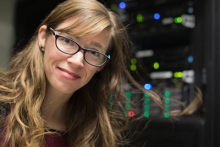October 29, 2015
Almost $2 million in grants will go a long way toward helping Professor Christine Isborn and colleagues at other universities learn more about the molecular processes involved in capturing solar energy, energy storage and telecommunications for the Department of Energy and the Department of Defense.
 The money will also allow Isborn to further work with upper-division students to help them succeed and stick with their chemistry studies.
The money will also allow Isborn to further work with upper-division students to help them succeed and stick with their chemistry studies.“It’s super exciting,” the quantum chemistry professor said. “I was notified about getting these two grants on the same day. It was one of the best days of my life.”
The Department of Energy is giving Isborn and theoretical chemists at Stanford University and Washington State University (WSU) $1.3 million over the next three years to model charge and energy transfer for molecules in solutions.
“None of the processes occurs in a vacuum,” Isborn said. “For example, photovoltaic materials can be molecules in solutions, crystals or polymers. We can model what happens to a molecule when light hits it, but we need to take into account the environment surrounding the molecule, too. We need to know how the solution changes the excitation.”
It’s a complex problem, and Isborn, with the School of Natural Sciences, and her colleagues each have their own area of expertise. She will work on quantum treatment of electrons and charge transfer, the Stanford researcher will work on the quantum treatment of protons and energy transport, and those at WSU will analyze the bulk solution surrounding the molecules.
The Department of Defense U.S. Air Force grant, for $600,000, carries both research and education components.
For the research portion, Isborn will examine the properties of molecules that are mixed together in polymers to learn more about their electro-optic properties, or how applying an electric field changes the optics.
The work is important in sending electrical signals, such as using switches to turn signals on or off at the speed of light. Her research will have applications in telecommunications.
There are two parts of the educational component. First, she wants to work through the Women in Science, Technology, Engineering and Math (STEM) group formed by faculty members at UC Merced. The Women in STEM group is open to everyone and offers discussion panels for students and opportunities for mentorships. Isborn said she wants to organize a workshop to offer practical advice, such as how to effectively apply for grants — something students might not fully understand in their first jobs.
Second, Isborn wants to develop workshops with extra math review for struggling chemistry students. Her postdoctoral researcher, Makenzie Provorse, is preparing some new, active-learning exercises to try in the classroom to help keep students engaged, even as the work gets increasingly complex.
Studies have found that about 40 percent of students planning engineering and science majors end up switching to other subjects or failing to get any degrees at all. STEM majors can be quite difficult and competitive, and some students find they need help with upper-level math.
“It will be great to help them enhance their math and study skills,” Isborn said. “We don’t want to see anyone fall behind.”
Program:



